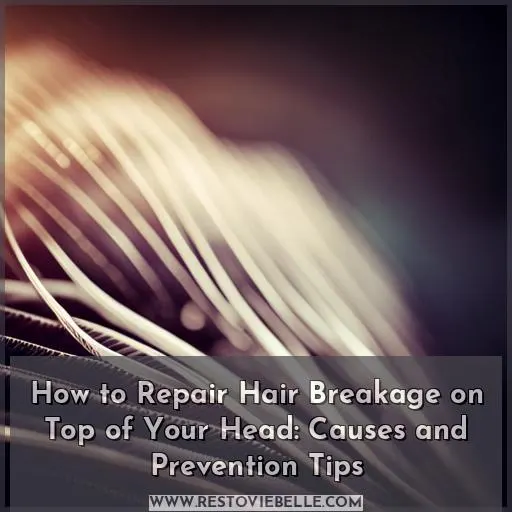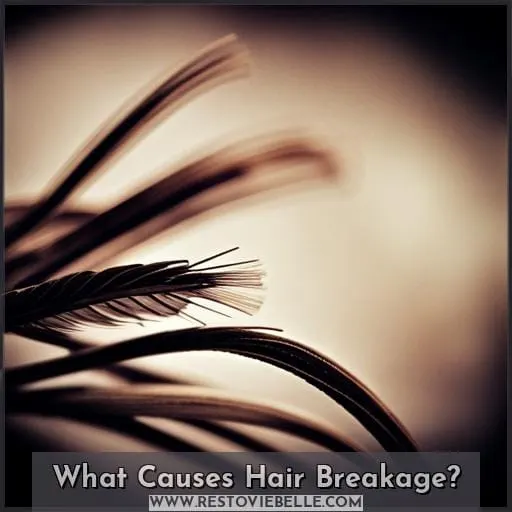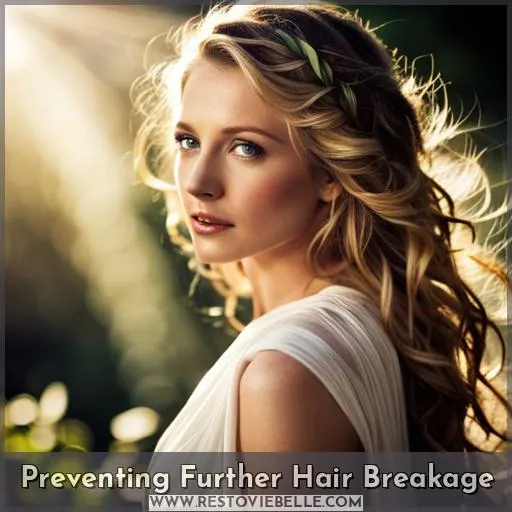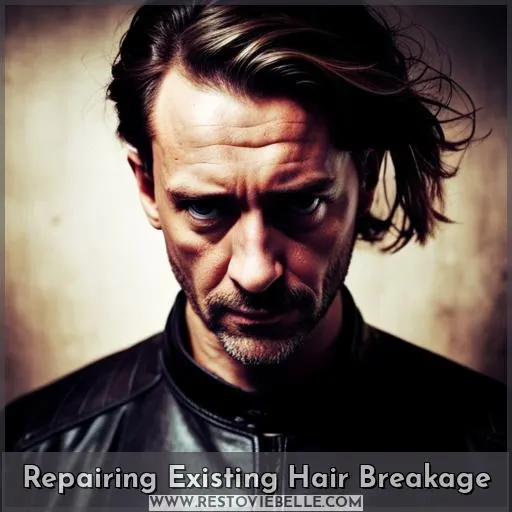This site is supported by our readers. We may earn a commission, at no cost to you, if you purchase through links.
 Your hair is your crown, your glory – so when it starts breaking at the top, it feels like your whole world is crashing down. Each day you stare dejectedly at the mirror, watching helplessly as your locks grow limper and more lackluster.
Your hair is your crown, your glory – so when it starts breaking at the top, it feels like your whole world is crashing down. Each day you stare dejectedly at the mirror, watching helplessly as your locks grow limper and more lackluster.
But don’t lose hope! This hair hurricane can be tamed with the right techniques. Learn what causes those aggravating strands to snap and the tricks to nourish your hair back to lusciousness. With some simple adjustments, you’ll be well on your way to reviving your ravishing, radiant tresses.
Say goodbye to sad, splitting strands and hello to the strong, sleek, sensational hair of your dreams!
Table Of Contents
Key Takeaways
- Limit the use of heat styling tools like blowdryers, flatirons, and curling irons to reduce damage from heat.
- Choose loose hairstyles like braids or buns rather than tight ponytails or buns that can pull on hair and cause breakage.
- Use silk hair accessories like scrunchies instead of elastic bands or metal clips that can snag hair.
- Apply conditioning hair masks or oils regularly to add moisture and nourish hair to reduce brittleness and breakage.
What Causes Hair Breakage?
At some point, we’ve all likely experienced hair breakage. But what actually causes it? You’ll want to take a closer look at heat styling tools, chemical processing, tight hairstyles, and improper brushing.
These factors can really stress and damage hair over time, leading to frustrating breakage, especially on the fragile crown area.
Heat Styling
Limiting your heat styling to once a week using the lowest setting with a protectant helps prevent breakage and keep your locks lush. First, use a heat protectant spray or serum before heat styling. This forms a barrier against damage.
Second, opt for ceramic, ionic, or titanium styling tools instead of conventional metal ones. These distribute heat more evenly and cause less damage. Third, style hair in sections for even heat distribution and to prevent over-styling one area.
Using heat styling in moderation and taking precautions to protect hair will minimize damage, allowing your hair to remain strong and healthy.
Chemical Processing
You’ve gotta be extra gentle with dyed locks, hon. Chemical processing like coloring, perming, straightening, bleaching, and relaxing can really damage your hair. Try to limit how often you dye and switch to ammonia-free options when you can. Doing a deep conditioning treatment after chemical treatments helps reduce the harm.
And don’t wash right after coloring or perming – give those chemicals time to work before removing them.
Tight Hairstyles
Let’s undo those tight ponytails and buns that cause breakage.
- Massage your scalp to increase blood flow.
- Use loose braids or gentle hair pins.
- Sleep in a silk bonnet or wrap hair in a silk scarf.
Dermatologists and trichologists say wearing your hair up tight strains the follicle, leading to traction alopecia and breakage over time. Try protective styles with soft scrunchies or fabric headbands instead of elastics and metal clips.
Handle wet hair gently and detangle with a wide-tooth comb to prevent rips and tears.
Improper Brushing
Yanking a tangled rope knots it tighter instead of loosening the snags. Brushing hair when wet or being too rough can damage strands, causing breakage. Use a wide-toothed comb and brush gently from ends to roots when hair is damp. Let hair air dry before brushing to avoid pulling water-weakened strands.
Damaged cuticles lead to splits; be gentle. Proper tools and technique strengthen hair, promote growth, and nurture a healthy scalp.
Preventing Further Hair Breakage
Limiting heat styling to once a week or less, using heat protectant serums before exposing hair to heat tools, changing up hairstyles to avoid daily stress on the same sections, and improving your brushing habits can all help reduce and prevent hair breakage.
You’ll want to handle wet hair very gently, opt for wide-toothed combs, and brush from the ends upward to keep your strands strong and minimize breakage.
Limit Heat Styling
Restricting heat tools to weekly touch-ups reduces damage to hair. Use heat protection sprays or serums before styling. Alternate heat styling with natural air drying. Replace tight hair ties with softer scrunchies or head wraps.
Here are some ideas for heat-free hairstyles:
- Braids – From basic braids to fishtail or Dutch braids, these protective styles prevent breakage.
- Buns – Messy buns, sock buns, top knots, and chignons keep hair up without heat. Use spin pins or soft scrunchies.
- Headscarves and bandanas – Wrap hair in silk or satin for a vintage flair.
- Ponytails – Switch up your part or height for different looks. Try braiding the ponytail too.
- Ribbons and headbands – Decorate your hair with soft accessories instead of elastics.
- Twists – Two-strand twists, flat twists, rope twists, etc. Neatly twist hair or loosely twist.
- Wet sets – Set your style with rollers or flexi-rods, then air dry for bouncy curls.
- Natural texture – Embrace your waves, curls, or coils with proper care.
Get creative and give your strands a break! Healthy habits lead to happy hair days.
Use Heat Protectants
Apply a heat protectant spray before using hot tools to shield strands. Protein-rich formulas coat each cuticle to prevent dehydration. Seek lightweight serums with humectants like glycerin for optimal moisture retention.
Silicones in these sprays temporarily seal the cuticle to block heat penetration. Your stylist can suggest brands compatible with your hair type. For best protection, distribute evenly and reapply as needed.
Consider alternate heatless styling methods to limit damage. Handle hot tools with care and avoid direct contact with hair to support growth.
Change Hairstyles
Loosen up those tight styles, girl. Changing your hairstyles and accessories can prevent hair breakage.
- Silk scrunchies instead of tight elastics
- Claw clips, soft headbands, fabric-covered bands
- Braids, ponytails, buns at varying heights
- Alternate your parting location
- Experiment with heatless curls overnight on silk pillowcases
Improve Brushing Habits
Use wide-toothed combs instead of normal combs. Opt for natural bristle brushes rather than nylon bristle brushes. Try detangling sprays and avoid brushing dry hair. Start brushing from the ends of your hair instead of at the roots.
Dermatologists and trichologists recommend handling strands gently and utilizing the proper tools to prevent damage to hair follicles. Regular scalp massages with oil can also improve scalp health for stronger strands.
Repairing Existing Hair Breakage
Repairing existing hair breakage on top of your head can seem daunting, but there are methods that can help get your hair back on track. Focusing on restoring moisture and protecting fragile strands is key to reducing further damage.
Deep conditioning treatments can help restore needed moisture. Oils that add shine and strength are also recommended. Getting regular trims will help eliminate split ends and allow your hair to grow in healthier.
Making dietary changes, like increasing your intake of foods rich in protein, vitamins, and minerals, can also help create stronger hair follicles.
Deep Conditioning Treatments
Nurture your tresses with soothing balms that saturate each strand, revitalizing your crowning glory.
- Weekly deep conditioning masks like shea butter or coconut oil hair masks can restore moisture to dry, damaged hair.
- Split end serums applied to the ends help seal cuticles and prevent further splitting.
- Oils such as argan, olive, and jojoba penetrate hair shafts to deeply moisturize hair when applied before washing.
- Scalp scrubs remove buildup and stimulate blood flow for healthier hair growth.
Deep conditioning provides parched strands with the hydration they crave for supple, shiny hair that thrives.
Oils for Shine and Strength
Massage your scalp with argan oil nightly for added shine. Natural oils moisturize hair from root to tip to prevent and repair breakage. Argan oil, rich in antioxidants, softens hair and boosts shine. Rosemary oil stimulates follicles, while calming black seed oil conditions.
Avocado oil is ultra-hydrating. Experiment to find your perfect oil or make a custom serum. Seal in vitamins with a pea-sized amount, gently massaging into hair and scalp. Oils strengthen each strand against damage for sleek, healthy hair.
Regular Trims
You’ll adore getting regular trims to keep your tips thriving. Hair experts suggest trimming split ends on a regular schedule, like clockwork. Cutting your hair every 6-12 weeks will keep your mane looking majestic instead of mangled.
Dietary Changes
Manage your stresses with a hearty protein, vitamin-packed diet. Hair needs nutrients for strength and growth like:
- Protein – Fish, eggs, beans
- Iron – Spinach, lentils, pumpkin seeds
- Zinc – Oysters, beef, wheat germ
Feed your hair a balanced diet and it will reward you with health. Remember, dietary changes alone cannot guarantee improved hair but do provide the building blocks for strength from within.
When to Seek Professional Help
Though frustrating, visit a trichologist if excessive shedding or thinning arises despite your best efforts. Trichologists and dermatologists have expertise to evaluate hair health and recommend solutions.
| Specialist | Expertise | When to Seek Help |
|---|---|---|
| Dermatologist | Skin, hair, nails, scalp disorders | Unexplained hair loss, scarring or soreness, other scalp conditions |
| Trichologist | Hair and scalp health, hair loss, treatments | Hair not improving with at-home care, need customized treatment plan |
| Endocrinologist | Hormones, hormone-related conditions | Sudden hair loss may indicate thyroid disorder or hormonal imbalance |
Healthy hair depends on internal well-being and external care. Seek professional guidance if self-care falls short. With their experience and diagnostic tools, specialists can identify underlying issues and customize a treatment plan for your unique needs.
Conclusion
So in the end, when hair breakage on top of your head becomes concerning, reaching out to experts for help is advisable. Dermatologists and trichologists possess the medical training to evaluate your unique situation, diagnose the underlying cause, and provide personalized treatment plans for repairing damage and preventing future breakage.
With their expertise, you can unravel the mystery behind your hair troubles and restore its strength, shine, and style once again.
The experts have the knowledge to get to the root of your hair issues. Their specialized skills allow them to assess what is causing the breakage and how to reverse it through customized therapies. You don’t have to struggle with weak, damaged hair on your own – consult the professionals to revive its health and beauty.
Their guidance can unravel the factors contributing to your specific hair woes. With a tailored regimen, the specialists can help repair split ends, increase tensile strength, reduce fragility, and stop breakage in its tracks.
In their competent hands, your locks can regain their radiance. So don’t hesitate to seek out their know-how for diagnosing and resolving your hair troubles at the source.









